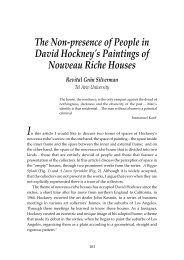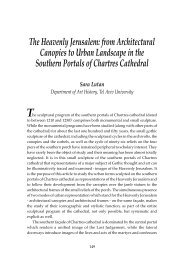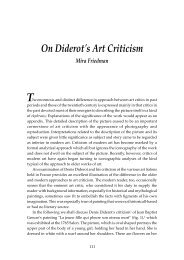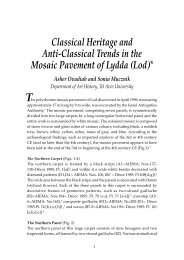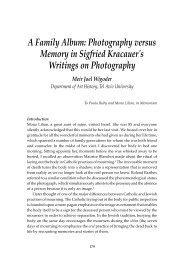The Temple in the Iconography of Early Christian Art Carla Gomez ...
The Temple in the Iconography of Early Christian Art Carla Gomez ...
The Temple in the Iconography of Early Christian Art Carla Gomez ...
Create successful ePaper yourself
Turn your PDF publications into a flip-book with our unique Google optimized e-Paper software.
none<strong>the</strong>less states that <strong>the</strong> scene takes place <strong>in</strong> front <strong>of</strong> "one or o<strong>the</strong>r temple"<br />
and that <strong>the</strong> figure <strong>in</strong> <strong>the</strong> pediment is <strong>the</strong> goddess Roma. He also wonders<br />
whe<strong>the</strong>r <strong>the</strong> <strong>Temple</strong> depicted is <strong>the</strong> one that stood <strong>in</strong> <strong>the</strong> Via Sacra <strong>in</strong> Rome or<br />
<strong>the</strong> one that Hadrian built <strong>in</strong> Aelia Capitol<strong>in</strong>a. 26 O<strong>the</strong>rs have also identified <strong>the</strong><br />
female figure as Roma. 27 Grabar concludes that <strong>the</strong> build<strong>in</strong>g is <strong>the</strong> <strong>Temple</strong> <strong>of</strong><br />
Venus and Roma erected by Emperor Hadrian and known as Templum Urbis<br />
(<strong>the</strong> City <strong>Temple</strong>). <strong>The</strong> fact that <strong>the</strong> mosaic shows <strong>the</strong> <strong>Temple</strong> with only four<br />
columns <strong>in</strong>stead <strong>of</strong> <strong>the</strong> ten it actually had, does not prove that <strong>the</strong> artist had<br />
not seen it: many co<strong>in</strong>s depict<strong>in</strong>g this <strong>Temple</strong> used <strong>the</strong> same conventional form.<br />
Grabar not only sees no contradiction <strong>in</strong> <strong>the</strong> appearance <strong>of</strong> a goddess on <strong>the</strong><br />
<strong>Temple</strong> but even f<strong>in</strong>ds it natural, s<strong>in</strong>ce it was logical to represent <strong>the</strong> <strong>Temple</strong> <strong>in</strong><br />
<strong>the</strong> form <strong>of</strong> <strong>the</strong> Templum Urbis, <strong>the</strong> symbol <strong>of</strong> Eternal Rome, <strong>the</strong> Br<strong>in</strong>ger <strong>of</strong><br />
Peace. And just as <strong>the</strong> personification <strong>of</strong> Roma on co<strong>in</strong>s symbolized concordia<br />
(fraternity), so was she understood by <strong>Christian</strong>s who perceived <strong>the</strong> unity<br />
between <strong>the</strong> Old and <strong>the</strong> New Testaments. Grabar identifies <strong>the</strong> figures<br />
welcom<strong>in</strong>g Jesus as <strong>the</strong> twelve priests <strong>of</strong> <strong>the</strong> <strong>Temple</strong> <strong>of</strong> Rome, ador<strong>in</strong>g <strong>the</strong> God<br />
become Man and acknowledg<strong>in</strong>g <strong>the</strong> commencement <strong>of</strong> His reign over <strong>the</strong><br />
Eternal City. Thus Roma, by <strong>the</strong> authority <strong>of</strong> Jesus, rises anew as <strong>the</strong> center <strong>of</strong><br />
<strong>the</strong> universe and becomes <strong>in</strong>terchangeable with Jerusalem. 28<br />
To some extent Schiller repeats <strong>the</strong>se perceptions, but adds that <strong>the</strong> chief<br />
priest (pontifex maximus) <strong>of</strong> <strong>the</strong> Templum Urbis was <strong>the</strong> emperor himself, so that<br />
<strong>in</strong> this case <strong>the</strong> <strong>Temple</strong> assumes a double significance, with <strong>the</strong> priests<br />
represent<strong>in</strong>g both <strong>the</strong> Jews and <strong>Christian</strong> Rome ready to accept her new Lord. 29<br />
Some twenty years later Grabar modified his op<strong>in</strong>ions. He terms <strong>the</strong> scene<br />
"a Purification" - referr<strong>in</strong>g apparently to <strong>the</strong> purification <strong>of</strong> Mary after giv<strong>in</strong>g<br />
birth and her entry <strong>in</strong>to <strong>the</strong> <strong>Temple</strong> - and now believes that <strong>the</strong> mosaic tends to<br />
show Rome as <strong>the</strong> heir <strong>of</strong> Old Testament Jerusalem, as implied by <strong>the</strong> use <strong>of</strong><br />
<strong>the</strong> pagan, Roman façade <strong>of</strong> <strong>the</strong> <strong>Temple</strong> <strong>of</strong> Roma and Augustus. <strong>The</strong> figure <strong>of</strong><br />
Roma <strong>in</strong> a pagan temple, <strong>in</strong> place <strong>of</strong> <strong>the</strong> Jerusalem <strong>Temple</strong>, symbolizes Roma<br />
Aeterna which had <strong>in</strong> some way changed its religion. 30<br />
Several less plausible op<strong>in</strong>ions and <strong>in</strong>terpretations have also been <strong>of</strong>fered.<br />
Venturi suggested <strong>the</strong> figure <strong>in</strong> <strong>the</strong> pediment to be that <strong>of</strong> <strong>the</strong> Saviour (Jesus)<br />
and <strong>the</strong> o<strong>the</strong>r figures - his Apostles. 31 Van Berchem and Clouzot perceived <strong>the</strong><br />
colonnade <strong>in</strong> <strong>the</strong> background as that <strong>of</strong> Solomon's <strong>Temple</strong>. 32 Leclercq, apparently<br />
draw<strong>in</strong>g on Venturi, suggests that <strong>the</strong> figure is Jesus between <strong>the</strong> haloed busts<br />
<strong>of</strong> his two chief disciples, Peter and Paul, and also identifies <strong>the</strong> temple and<br />
colonnade as those <strong>of</strong> K<strong>in</strong>g Solomon. 33 Nei<strong>the</strong>r proposition is plausible. With<br />
respect to <strong>the</strong> first, <strong>the</strong> figure depicted appears identical to <strong>the</strong> figure <strong>of</strong> <strong>the</strong><br />
goddess Roma that appears on <strong>in</strong>numerable temples, statues and co<strong>in</strong>s.<br />
66


